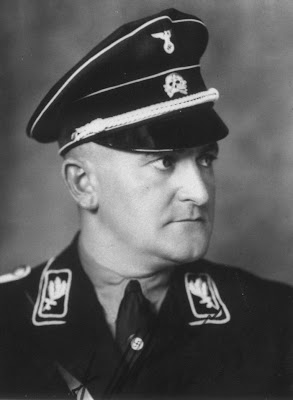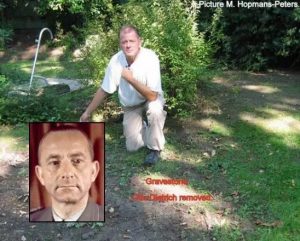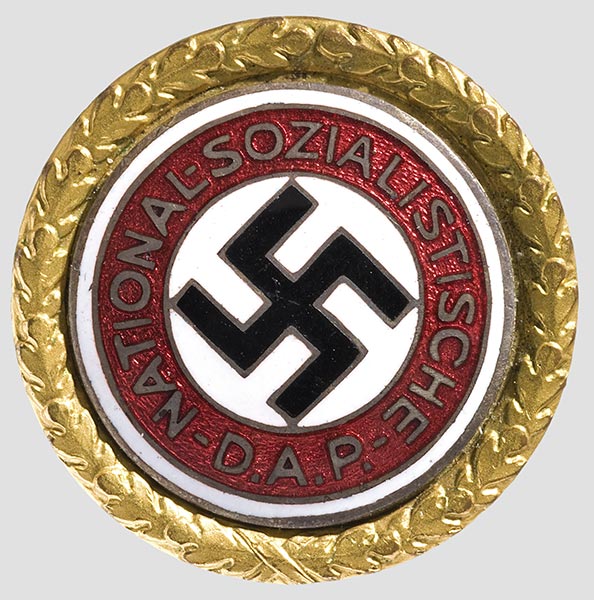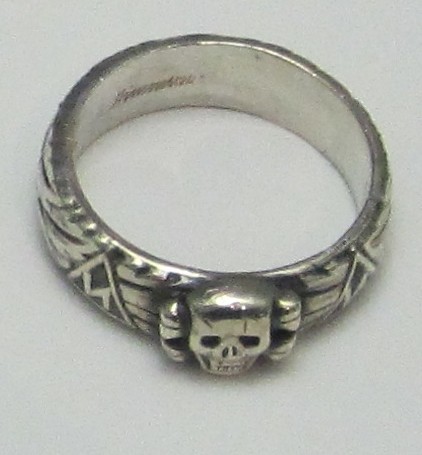Weitzel, Friedrich “Fritz” Philip, born 27-04-1904 in Frankfurt am Main  . After training as a locksmith, Weitzel was active in the Sozialistische Arbeiter-Jugend. In 1924 he became a member of the SA
. After training as a locksmith, Weitzel was active in the Sozialistische Arbeiter-Jugend. In 1924 he became a member of the SA  He became an early member of Nazi Party
He became an early member of Nazi Party  nr. 18.833, in 1925 and of the SS,
nr. 18.833, in 1925 and of the SS,  nr. 408, in 1926. In 1930 he was promoted to leader of SS in Rheinland and Ruhr. On 12-05-1932, Weitzel was involved in a violent attack on journalist Helmuth Klotz
nr. 408, in 1926. In 1930 he was promoted to leader of SS in Rheinland and Ruhr. On 12-05-1932, Weitzel was involved in a violent attack on journalist Helmuth Klotz 
 in the restaurant of the Reichstag. Weitzel and three other NSDAP MPs were excluded from parliament for 30 days. The lawsuit had to be interrupted because the excluded refused to leave the plenum. On May 14, Weitzel, SA Gruppenführer Wilhelm Ferdinand Stegmann
in the restaurant of the Reichstag. Weitzel and three other NSDAP MPs were excluded from parliament for 30 days. The lawsuit had to be interrupted because the excluded refused to leave the plenum. On May 14, Weitzel, SA Gruppenführer Wilhelm Ferdinand Stegmann  and Edmund Karl Heines
and Edmund Karl Heines  were sentenced to three months’ imprisonment by the lay court in Berlin-Mitte for jointly committing bodily harm. Klotz was arrested by the Gestapo in July 1940 after France’s defeat, and taken to Sachsenhausen concentration camp. The People’s Court under jurist and fanatic Nazi, Roland Freisler,
were sentenced to three months’ imprisonment by the lay court in Berlin-Mitte for jointly committing bodily harm. Klotz was arrested by the Gestapo in July 1940 after France’s defeat, and taken to Sachsenhausen concentration camp. The People’s Court under jurist and fanatic Nazi, Roland Freisler, 
 sentenced Helmut Klotz to death on 27-11-1942. He was murdered in Berlin-Plötzensee on 03-02-1943. SA Gruppenführer Wilhelm Ferdinand Stegmann as SS Obersturmführer of the reserve, came to the SS special unit Dirlewanger, a unit in which former prisoners and concentration camp prisoners often served. He fell on the Eastern Front in the fighting over Budapest on 15-12-1944, age 45, in Ipolyság.
sentenced Helmut Klotz to death on 27-11-1942. He was murdered in Berlin-Plötzensee on 03-02-1943. SA Gruppenführer Wilhelm Ferdinand Stegmann as SS Obersturmführer of the reserve, came to the SS special unit Dirlewanger, a unit in which former prisoners and concentration camp prisoners often served. He fell on the Eastern Front in the fighting over Budapest on 15-12-1944, age 45, in Ipolyság.
 . After training as a locksmith, Weitzel was active in the Sozialistische Arbeiter-Jugend. In 1924 he became a member of the SA
. After training as a locksmith, Weitzel was active in the Sozialistische Arbeiter-Jugend. In 1924 he became a member of the SA  He became an early member of Nazi Party
He became an early member of Nazi Party  nr. 18.833, in 1925 and of the SS,
nr. 18.833, in 1925 and of the SS,  nr. 408, in 1926. In 1930 he was promoted to leader of SS in Rheinland and Ruhr. On 12-05-1932, Weitzel was involved in a violent attack on journalist Helmuth Klotz
nr. 408, in 1926. In 1930 he was promoted to leader of SS in Rheinland and Ruhr. On 12-05-1932, Weitzel was involved in a violent attack on journalist Helmuth Klotz 
 in the restaurant of the Reichstag. Weitzel and three other NSDAP MPs were excluded from parliament for 30 days. The lawsuit had to be interrupted because the excluded refused to leave the plenum. On May 14, Weitzel, SA Gruppenführer Wilhelm Ferdinand Stegmann
in the restaurant of the Reichstag. Weitzel and three other NSDAP MPs were excluded from parliament for 30 days. The lawsuit had to be interrupted because the excluded refused to leave the plenum. On May 14, Weitzel, SA Gruppenführer Wilhelm Ferdinand Stegmann  and Edmund Karl Heines
and Edmund Karl Heines  were sentenced to three months’ imprisonment by the lay court in Berlin-Mitte for jointly committing bodily harm. Klotz was arrested by the Gestapo in July 1940 after France’s defeat, and taken to Sachsenhausen concentration camp. The People’s Court under jurist and fanatic Nazi, Roland Freisler,
were sentenced to three months’ imprisonment by the lay court in Berlin-Mitte for jointly committing bodily harm. Klotz was arrested by the Gestapo in July 1940 after France’s defeat, and taken to Sachsenhausen concentration camp. The People’s Court under jurist and fanatic Nazi, Roland Freisler, 
 sentenced Helmut Klotz to death on 27-11-1942. He was murdered in Berlin-Plötzensee on 03-02-1943. SA Gruppenführer Wilhelm Ferdinand Stegmann as SS Obersturmführer of the reserve, came to the SS special unit Dirlewanger, a unit in which former prisoners and concentration camp prisoners often served. He fell on the Eastern Front in the fighting over Budapest on 15-12-1944, age 45, in Ipolyság.
sentenced Helmut Klotz to death on 27-11-1942. He was murdered in Berlin-Plötzensee on 03-02-1943. SA Gruppenführer Wilhelm Ferdinand Stegmann as SS Obersturmführer of the reserve, came to the SS special unit Dirlewanger, a unit in which former prisoners and concentration camp prisoners often served. He fell on the Eastern Front in the fighting over Budapest on 15-12-1944, age 45, in Ipolyság.Weitzel became Polizeipräsident in Düsseldorf in 1933, and Höherer SS- und Polizeiführer West in 1938. During 1939 Weitzel wrote the book Celebrations of the SS Family  which described the holidays to be celebrated along with how married SS men and their family’s should celebrate them.
which described the holidays to be celebrated along with how married SS men and their family’s should celebrate them.  This book written by Weitzel described how the Julleuchter
This book written by Weitzel described how the Julleuchter  should be used, which was a Yuletide gift by Reichsleiter Heinrich Himmler
should be used, which was a Yuletide gift by Reichsleiter Heinrich Himmler 
 to the SS. Following the German invasion of Norway on 09-04-1940, Weitzel was brought to Norway on 21 April to become Höherer SS- und Polizei Führer in the country’s capital, Oslo. His successor as HSSPF, Höheren SS- und Polizeiführer, became SS-Gruppenführer
to the SS. Following the German invasion of Norway on 09-04-1940, Weitzel was brought to Norway on 21 April to become Höherer SS- und Polizei Führer in the country’s capital, Oslo. His successor as HSSPF, Höheren SS- und Polizeiführer, became SS-Gruppenführer  Theodor Friedrich Wilhelm Hermann Berkelmann.
Theodor Friedrich Wilhelm Hermann Berkelmann.  Weitzel would not last in this position for long, however, as he died, age 36 on 19-06-1940, in an aerial attack on his home town Düsseldorf during a visit there in June 1940.
Weitzel would not last in this position for long, however, as he died, age 36 on 19-06-1940, in an aerial attack on his home town Düsseldorf during a visit there in June 1940.  In the vicinity of Martin-Lutherplein, Weitzel, strongly under the influence of alcohol, was hit by a grenade after he carelessly got out of his service car. The SS-Standarte 20 (Düsseldorf) was honored SS-Standarte “Fritz Weitzel” by a Führerbevel two days after Weitzel’s death on 21-06-1940, age 36. Weitzel’s successor as chief superintendent became his deputy SS Brigadeführer
In the vicinity of Martin-Lutherplein, Weitzel, strongly under the influence of alcohol, was hit by a grenade after he carelessly got out of his service car. The SS-Standarte 20 (Düsseldorf) was honored SS-Standarte “Fritz Weitzel” by a Führerbevel two days after Weitzel’s death on 21-06-1940, age 36. Weitzel’s successor as chief superintendent became his deputy SS Brigadeführer  August Alexander Karl Korreng.
August Alexander Karl Korreng.  His successor as HSSPF “Nord” became SS Obergruppenführer
His successor as HSSPF “Nord” became SS Obergruppenführer  Friedrich Wilhelm Otto Rediess,
Friedrich Wilhelm Otto Rediess,  who also served in SS-Standarte 20. SS Brigadeführer Korreng committed suicide on 07-06-1945, age 67 and SS Obergruppenführer Rediess Rediess committed suicide by a self-inflicted gunshot wound upon the collapse of the Third Reich in Norway on 08-05-1945, age 44. His remains were destroyed when Reichskommissar (Commissary) of Norway, Josef Terboven
who also served in SS-Standarte 20. SS Brigadeführer Korreng committed suicide on 07-06-1945, age 67 and SS Obergruppenführer Rediess Rediess committed suicide by a self-inflicted gunshot wound upon the collapse of the Third Reich in Norway on 08-05-1945, age 44. His remains were destroyed when Reichskommissar (Commissary) of Norway, Josef Terboven  age 47, killed himself by detonating fifty kilograms of dynamite in a bunker on the Skaugum compound the same day..
age 47, killed himself by detonating fifty kilograms of dynamite in a bunker on the Skaugum compound the same day..
 which described the holidays to be celebrated along with how married SS men and their family’s should celebrate them.
which described the holidays to be celebrated along with how married SS men and their family’s should celebrate them.  This book written by Weitzel described how the Julleuchter
This book written by Weitzel described how the Julleuchter  should be used, which was a Yuletide gift by Reichsleiter Heinrich Himmler
should be used, which was a Yuletide gift by Reichsleiter Heinrich Himmler 
 to the SS. Following the German invasion of Norway on 09-04-1940, Weitzel was brought to Norway on 21 April to become Höherer SS- und Polizei Führer in the country’s capital, Oslo. His successor as HSSPF, Höheren SS- und Polizeiführer, became SS-Gruppenführer
to the SS. Following the German invasion of Norway on 09-04-1940, Weitzel was brought to Norway on 21 April to become Höherer SS- und Polizei Führer in the country’s capital, Oslo. His successor as HSSPF, Höheren SS- und Polizeiführer, became SS-Gruppenführer  Theodor Friedrich Wilhelm Hermann Berkelmann.
Theodor Friedrich Wilhelm Hermann Berkelmann.  Weitzel would not last in this position for long, however, as he died, age 36 on 19-06-1940, in an aerial attack on his home town Düsseldorf during a visit there in June 1940.
Weitzel would not last in this position for long, however, as he died, age 36 on 19-06-1940, in an aerial attack on his home town Düsseldorf during a visit there in June 1940.  In the vicinity of Martin-Lutherplein, Weitzel, strongly under the influence of alcohol, was hit by a grenade after he carelessly got out of his service car. The SS-Standarte 20 (Düsseldorf) was honored SS-Standarte “Fritz Weitzel” by a Führerbevel two days after Weitzel’s death on 21-06-1940, age 36. Weitzel’s successor as chief superintendent became his deputy SS Brigadeführer
In the vicinity of Martin-Lutherplein, Weitzel, strongly under the influence of alcohol, was hit by a grenade after he carelessly got out of his service car. The SS-Standarte 20 (Düsseldorf) was honored SS-Standarte “Fritz Weitzel” by a Führerbevel two days after Weitzel’s death on 21-06-1940, age 36. Weitzel’s successor as chief superintendent became his deputy SS Brigadeführer  August Alexander Karl Korreng.
August Alexander Karl Korreng.  His successor as HSSPF “Nord” became SS Obergruppenführer
His successor as HSSPF “Nord” became SS Obergruppenführer  Friedrich Wilhelm Otto Rediess,
Friedrich Wilhelm Otto Rediess,  who also served in SS-Standarte 20. SS Brigadeführer Korreng committed suicide on 07-06-1945, age 67 and SS Obergruppenführer Rediess Rediess committed suicide by a self-inflicted gunshot wound upon the collapse of the Third Reich in Norway on 08-05-1945, age 44. His remains were destroyed when Reichskommissar (Commissary) of Norway, Josef Terboven
who also served in SS-Standarte 20. SS Brigadeführer Korreng committed suicide on 07-06-1945, age 67 and SS Obergruppenführer Rediess Rediess committed suicide by a self-inflicted gunshot wound upon the collapse of the Third Reich in Norway on 08-05-1945, age 44. His remains were destroyed when Reichskommissar (Commissary) of Norway, Josef Terboven  age 47, killed himself by detonating fifty kilograms of dynamite in a bunker on the Skaugum compound the same day..
age 47, killed himself by detonating fifty kilograms of dynamite in a bunker on the Skaugum compound the same day..Like SS Obergruppenführer , Reichsminister of Food and Agriculture, Richard Walther Darré. 
 Weitzel was one of the key figures concerning the cultural aspects of the SS. His efforts helped Himmler with what he call the “arteigene Kultur”, which was the recreated German pagan religion.
Weitzel was one of the key figures concerning the cultural aspects of the SS. His efforts helped Himmler with what he call the “arteigene Kultur”, which was the recreated German pagan religion.

 Weitzel was one of the key figures concerning the cultural aspects of the SS. His efforts helped Himmler with what he call the “arteigene Kultur”, which was the recreated German pagan religion.
Weitzel was one of the key figures concerning the cultural aspects of the SS. His efforts helped Himmler with what he call the “arteigene Kultur”, which was the recreated German pagan religion.Weitzel was personally involved in the interrogations and torture during the “machtergreifung” “taking power” phase, as described, for example, by Wolfgang Langhoff in his book The Moorsoldaten. Local historiography describes the “Razzia van Gerresheim” of 05-05-1933 as an initiative of Weitzel. In the workers’ quarter, extremely brutal attacks were carried out by the police, SS and SA. Numerous KPD members and Social Democrats have been captured and publicly ridiculed.
Like Richard Walther “Ricardo” Darré,  Weitzel was one of the key figures concerning the cultural aspects of the SS. His book Die Gestaltung der Feste helped Himmler with what he called the “arteigene Kultur”, which was the recreated German pagan religion.
Weitzel was one of the key figures concerning the cultural aspects of the SS. His book Die Gestaltung der Feste helped Himmler with what he called the “arteigene Kultur”, which was the recreated German pagan religion.
 Weitzel was one of the key figures concerning the cultural aspects of the SS. His book Die Gestaltung der Feste helped Himmler with what he called the “arteigene Kultur”, which was the recreated German pagan religion.
Weitzel was one of the key figures concerning the cultural aspects of the SS. His book Die Gestaltung der Feste helped Himmler with what he called the “arteigene Kultur”, which was the recreated German pagan religion.Death and burial ground of Weitzel, Friedrich “Fritz” Philip.


 Fritz Weitzel is buried with his wife Betty, born Wengenroth, who died age 86, on 04-08-1998, on the North cemetery of Düsseldorf. Close by are the graves of different “famous” WW II personalities, Generalmajor der Infanterie, Kommandeur der 271th Volkgrenadier Division, Martin Bieber, Hitler’s Press Chief SS Obergruppenführer, Otto Dietrich,
Fritz Weitzel is buried with his wife Betty, born Wengenroth, who died age 86, on 04-08-1998, on the North cemetery of Düsseldorf. Close by are the graves of different “famous” WW II personalities, Generalmajor der Infanterie, Kommandeur der 271th Volkgrenadier Division, Martin Bieber, Hitler’s Press Chief SS Obergruppenführer, Otto Dietrich, 
 Generalmajor der Flieger, Kommandeur 7th Flak Division, Alfred Erhard, the former commander of concentration camp Westerbork, in the Netherlands SS Obersturmführer, Albert Gemmeker, Anne Frank and her family, father, mother and sister Margo, were integrated in this camp, before leaving to Bergen Belsen, where they died, father Otto Frank survived, he died old age 91, on 19-08-1980,
Generalmajor der Flieger, Kommandeur 7th Flak Division, Alfred Erhard, the former commander of concentration camp Westerbork, in the Netherlands SS Obersturmführer, Albert Gemmeker, Anne Frank and her family, father, mother and sister Margo, were integrated in this camp, before leaving to Bergen Belsen, where they died, father Otto Frank survived, he died old age 91, on 19-08-1980,

 remarried in Bazel, Switzerland. Also buried there are Hitler’s favourite architects, Hermann Giesler and Paul Giesler and Arno Breker.
remarried in Bazel, Switzerland. Also buried there are Hitler’s favourite architects, Hermann Giesler and Paul Giesler and Arno Breker.
 Generalleutnant der Artillerie, Kommandeur der 526th Infanterie Division, Fritz Kühne, diplomate, Ernst vom Rath,
Generalleutnant der Artillerie, Kommandeur der 526th Infanterie Division, Fritz Kühne, diplomate, Ernst vom Rath, 
 killed in Paris by the Jewish boy Herschel Grynspan
killed in Paris by the Jewish boy Herschel Grynspan 
 , and General der Panzertruppe, Kommandeur 1st Panzer Division
, and General der Panzertruppe, Kommandeur 1st Panzer Division .svg/682px-1st_Panzer_Division_(1943-1945).svg.png) , Walther Nehring.
, Walther Nehring.























Leave a Reply